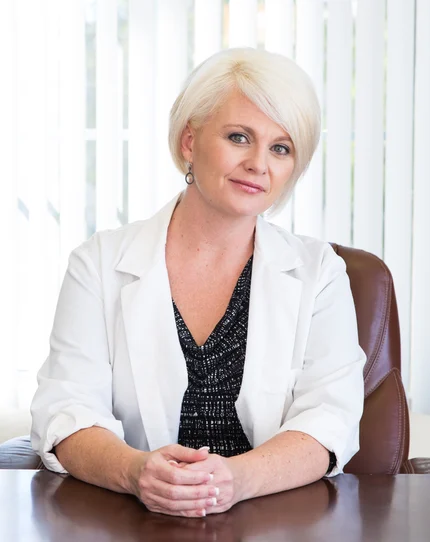We all know that menopause can come with a multitude of not so pleasant symptoms. Women know about hot flashes, night sweats, mood changes, weight gain, and lack of energy. Those are commonly talked about and somewhat expected.
For a lot of women though one of the most shocking, traumatic, and sadly least discussed, symptoms of menopause is hair loss. Roughly forty percent of women experience hair loss during or after menopause, and most of the time they are at a complete loss about why it’s happening or what they can do about it. Learn more menopausal hair loss and get free consult from an expert.
Female Pattern Hair Loss and Menopause
Whether it is labeled as female pattern hair loss, hormonal hair loss, or Androgenic Alopecia (the fancy medical term that simply means genetic hair loss), it is all related to one thing: hormones – specifically estrogen and testosterone. To get very specific, hair loss associated with menopause is a genetic sensitivity of the hair follicle to DHT, or dihydrotestosterone, which is what the body converts testosterone into.
This genetic sensitivity can occur anywhere between the frontal hair line and the crown area, and for women usually results in a slow progression of diffuse thinning throughout the area.
But why does it happen during or after menopause?
Because estrogen protects the hair follicles between the frontal hair line and crown area from DHT, and estrogen levels significantly decline during menopause and after. More simply, women lose their “estrogen buffer.” After puberty and up to their mid-thirties, women have relatively high levels of estrogen and much lower levels of testosterone and DHT.
As women get older estrogen levels naturally begin to decline, while testosterone levels generally stay the same. If a woman has the genetic trait for DHT sensitivity, depending on how sensitive her hair follicles are, menopause is usually the time she starts to notice thinning.
For most women, it is a gradual process not usually accompanied by an increased amount of shedding. For some women, however, especially those whose doctors put them on hormone replacement therapy with testosterone included, the thinning can be rapid and very traumatic.
It is at this point when women start to notice a difference in the volume of their hair, and many of them start to feel embarrassed, ashamed, self-conscious, or hopeless that there is anything they can do to reverse the unexpected onslaught of hair loss.
Do not lose hope! There are effective ways to slow down and stop the thinning associated with female pattern hair loss, and achieve regrowth.
For our client’s pattern hair loss, we have found that combining the following therapies provides the most effective regrowth when used correctly:
- Natural Hormonal Support – Naturally supporting estrogen, through the use of phytoestrogens like black cohosh and evening primrose, safely replaces the “estrogen buffer” to protect hair follicles from DHT. This slows down and stops the thinning process.
- Topical Scalp Stimulation – To effectively grow new hair and improve the thickness of existing hairs it is important to consistently and continually provide stimulation to keep the follicles working and overcome DHT impact.
- Low Level Laser Stimulation – Laser stimulation is recommended to increase circulation to the scalp and improve the rate of regrowth by increasing energy production in the cells of the hair follicles.
- Nutritional Support – A complete multivitamin specific to hair growth is suggested to ensure there are no nutritional deficiencies that may prohibit growth, and provide the hair follicles with all of the necessary components to regrow strong healthy hair.
Learn more about the Evolution Hair Loss Institute program to treat menopausal hair loss or simply call 480-222-4247 to book a consultation.

However, effective hair loss treatment is not a “one size fits all” scenario. In addition to the above recommendations, it is also important to make sure that health or lifestyle is not contributing to loss or thinning, or a lack of healthy regrowth. High stress, poor diet, lack of sleep or exercise, and many prescription medications can have a negative impact on hair health overall. As can illnesses, thyroid imbalances, vitamin deficiencies, and poor scalp conditions.
It is not unusual for women to become overwhelmed about what to do, or how to determine the best course of action. This is where we come in, and it is probably no surprise that over fifty percent of our clients, both in our clinic and around the country, are women.
During a consultation, either in our clinic or over the phone, we look at a woman’s overall health history, family history, and lifestyle to determine what the cause or causes of hair loss are. The majority of the time we recommend some blood tests to rule out thyroid issues, vitamin or iron deficiencies, or high testosterone levels.
Once we have all of the necessary information we can make effective, individualized recommendations to slow down and stop the thinning process and get the fastest amount of regrowth in the shortest amount of time. We have become very familiar with how to effectively treat female pattern hair loss, and women all over the country are having success with our individualized recommended treatment programs.
Call 480-222-4247 to book your free phone or clinical consultation for successful menopausal hair loss today!

Author: Kelly Nipper WTS
Trichologist with Evolution Hair Loss Institute
USA Office: 480-222-4247
Phone and Clinical Consultation provided Monday – Friday PST.
-Offering Phone Consults for USA and Canada
-Offering Clinical Consult in Arizona
Free Consultation provided for new clients


